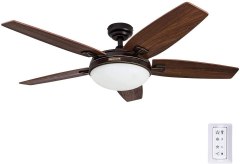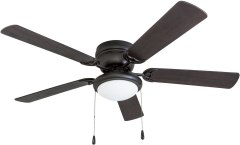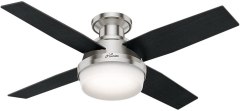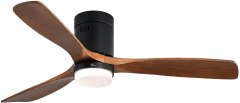
A handsome unit with semi-flush installation that moves a lot of air for medium to large rooms.
A handsome unit with semi-flush installation that moves a lot of air for medium to large rooms.
Attractive modern design. Includes semi-flush mount for flat or angled installation. Measures 12.5 inches from ceiling to globe light with down rod. Can also be flush-mounted. Moves 5,202 cfm with 48-inch blades for medium to large rooms. Includes light bulbs and remote control.
Included bulbs seem dim. Airflow can be affected by close flush-mounting.

This affordable model mounts flush to the ceiling and includes a light fixture with bulb.
This affordable model mounts flush to the ceiling and includes a light fixture with bulb.
Mounts flush to the ceiling. Suits styles including traditional, rustic, and industrial. Measures 11.5 inches to apex of light fixture. Reversible 52-inch blades in black and walnut. Moves up to 4,797 cfm on high. Includes bulbs for lighting.
Does not offer a remote control. Pull cords only.

This model can be mounted flush or with a short down rod and includes integrated LED lighting.
This model can be mounted flush or with a short down rod and includes integrated LED lighting.
Installs flush to the ceiling or with included 4-inch down rod. Sleek, modern design. Five 52-inch blades move 3,589 cfm on high to cool rooms up to 400 square feet. Integrated 16-watt LED lighting. Pull-cord control for light and fan are clearly labeled.
Doesn't come with a remote. Moves less CFM than other models.

An excellent ceiling fan with a minimalist design.
An excellent ceiling fan with a minimalist design.
This ceiling fan is available in multiple colors and features a remote control. LED lighting. The fan has four blades. You can change the speed of the fan and the brightness of the light. Compliments a room. Trusted brand.
The light tends to turn off and on or flicker.

This model boasts on-trend styling, flush mounting, 6 fan speeds, and LED lighting.
This model boasts on-trend styling, flush mounting, 6 fan speeds, and LED lighting.
Stylish, contemporary 3-blade design. Mounts flush to the ceiling; 8 inches to blades. Moves 5,021 cfm with 60-inch blades at 13-degree pitch for powerful performance. Blades made of real wood. Six fan speeds. Built-in LED light. Comes with remote control.
Some find the light too weak for their taste.

We recommend these products based on an intensive research process that's designed to cut through the noise and find the top products in this space. Guided by experts, we spend hours looking into the factors that matter, to bring you these selections.

If your home has low ceilings, you might struggle to find fans and light fixtures that won’t dwarf the space – or cause any head injuries. In that case, your best option is a low-profile ceiling fan.
Low-profile ceiling fans hang flush with the ceiling, without a downrod, and so fit better in small spaces. Once you’ve found a fan that’s the right size, there are other decisions to make. What kind of motor? What type of blades? What finish? Do you want remote control or a wall switch? What about a light? It can all seem a little overwhelming if you’re not sure what you’re looking for.

If you’re looking for a low-profile ceiling fan for your back porch, you’re going to have very different requirements than if you’re looking for a fan for your living room. First, make sure that the fan you choose is designed for its intended location.
The ceiling fan motor is a crucial feature because it determines how much air gets moved around, how energy efficient the fan is, and how loud the fan is.
AC motor: Ceiling fan motors most commonly use alternating current (AC), and these types are usually the most affordable. However, AC motors are usually larger than DC motors, which means that the fan itself is also much larger. These also tend to produce more noise and heat while operating.
DC motor: Direct current (DC) fan motors are a relatively new addition to ceiling fans, but they’re quickly gaining popularity because they’re smaller, lighter, and more efficient than AC motors. DC fan motors consume 70% less power on average and are virtually silent when operating. The smaller motor size also means a smaller housing that doesn’t take up as much room on your ceiling.
DC fan motors also generate more airflow, which means that the fan will cool the room better. High airflow is especially important when choosing a low-profile ceiling fan. The blades are so close to the ceiling that it can be difficult to move the air effectively, so a wise choice would be a powerful fan motor that has a minimum airflow of 5,000 cubic feet per minute (cfm) on its highest setting.
When evaluating fan blades, you should focus more on the material than the number. The number of blades doesn’t significantly impact the airflow, so it’s more of an aesthetic choice. Fan blades are made of a number of different materials, each of which has its own pros and cons.
MDF: Medium-density fiberboard (MDF) blades are lightweight and covered with a laminate coating to resemble wood. These are common, especially at the the lower end of the price range. Some blades are a different color on each side, so you can choose the one that best matches your room. These blades don’t hold up well in moisture (they may begin to droop) and so aren’t ideal for humid environments.
Wood: Wooden blades are thicker and heavier than MDF blades and can add a luxurious look to your space. These blades work best indoors but can also withstand some exposure to moisture outdoors. Wooden blades usually cost more than other types.
Plastic: Plastic is another inexpensive option for fan blades because it’s easy to make and mold into the proper shape. These blades are a good choice if you’re looking for a fan for use outdoors because they won’t droop or fall apart in the elements. Plastic blades aren’t as common as MDF blades, but like MDF, some plastic blades are reversible.
Blade size: Ideally, you want at least seven feet between the ceiling fan and the floor, which shouldn’t be an issue if you’re going with a low-profile ceiling fan. But you also have to think about the length of the blades and how they will fit into your space. In order to avoid having your fan blades dwarf the space, there should be at least 1.5 feet between the tips of the fan blades and the walls.
Not all low-profile ceiling fans come with lights. It’s a matter of personal preference and what the space requires. If the room is already well lit, you might not want a fan with a light. But a light on the fan can be a nice addition if the room is dimly lit.
Keep in mind that a fan with lights might hang a little lower than a fan without lights, so you have to make sure that it won’t hang too low or overpower the space. Check to see that any lights that come with the fan are bright enough for your needs. Sometimes the included bulbs are too dim, so you might want to replace them.
Some fans that don’t come with a light built in still have the connections, so you can add a light later if you want to. However, these lights attach to the bottom of the fan and often hang down much lower than lights that come built into a fan.
Most ceiling fans come with a basic pull chain that enables you to adjust the fan’s speed and turn any lights on and off. But this isn’t always ideal, especially if the ceiling is high. In that case, you’ll want to look for a fan that you can control with either a wall switch or remote control. A remote control offers the ultimate convenience because you can adjust the fan’s settings and turn any lights on and off without having to move.
Some low-profile ceiling fans are easier to install than others. This won’t be an issue if you plan to hire someone to install it for you, but if you’re going to do it yourself, get some idea of how simple the installation process is by reading through customer reviews. If the model you’re looking at has a lot of complaints about the installation, that probably isn’t the right choice unless you have a lot of technical know-how.

Low-profile ceiling fans range in price from $50 or over $300, depending on what you’re looking for.
For under $100, you can expect to get a basic, no-frills low-profile ceiling fan. The blades will likely be MDF, and you’ll probably be limited to pull-chain controls. These fans are usually only safe for indoor use and might end up warping or breaking if exposed to a lot of moisture.
There are more style options if you spend between $100 and $200. These fans are more likely to have integrated lights and possibly blades made of solid wood. If you want a fan with a quiet and efficient DC motor, you should expect to spend at least this much.
If you spend over $200, you’ll get more advanced features like dimmable lights and a reverse function. Most of these fans come with DC motors and sturdy, high-quality blades. You’ll have to decide if these extras are worth the added cost to you.
If you’re replacing an old ceiling fan, you should be able to reuse the existing wiring.
Ceiling fans must be hung from a junction box that is fan rated to ensure that the fan’s weight won’t pull it out of the ceiling.
If your fan has reversible rotation, run it counterclockwise in the summer for a cooler breeze and clockwise in the winter to push the warmer air back down.
If your ceiling fan light is difficult to reach, install LED bulbs because these usually last the longest.

A. That depends on several factors, including whether or not the fan has a light attached. There should be at least eight inches between the fan blades and the ceiling in order for the fan to circulate an adequate amount of air.
A. No. Low-profile ceiling fans are not equipped to hang from an angled ceiling. You will need to choose a fan that comes with a downrod.
A. Always read your owner’s manual for any details on required maintenance or cleaning. In general, these fans require little maintenance, but if they haven’t been used in a while, you might have to dust the tops of the blades.
Get emails you’ll love.
Learn about the products you’re wondering if you should buy and get advice on using your latest purchases.
